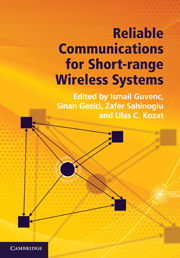Book contents
- Frontmatter
- Contents
- List of contributors
- 1 Short-range wireless communications and reliability
- Part I High-rate systems
- Part II Low-rate systems
- 6 ZigBee networks and low-rate UWB communications
- 7 Impact of channel estimation on reliability
- 8 Interference mitigation and awareness for improved reliability
- 9 Characterization of Wi-Fi interference for dynamic channel allocation in WPANs
- 10 Energy saving in low-rate systems
- Part II Selected topics for improved reliability
- Index
10 - Energy saving in low-rate systems
from Part II - Low-rate systems
Published online by Cambridge University Press: 01 June 2011
- Frontmatter
- Contents
- List of contributors
- 1 Short-range wireless communications and reliability
- Part I High-rate systems
- Part II Low-rate systems
- 6 ZigBee networks and low-rate UWB communications
- 7 Impact of channel estimation on reliability
- 8 Interference mitigation and awareness for improved reliability
- 9 Characterization of Wi-Fi interference for dynamic channel allocation in WPANs
- 10 Energy saving in low-rate systems
- Part II Selected topics for improved reliability
- Index
Summary
In low-rate wireless networks, energy saving has been one of the recent important research challenges. Compared to high-rate networks designed for multimedia data streaming or large file transfer, low-rate systems focus mainly on monitoring and control applications. In most of these applications, devices are expected to have low data rates and to operate on battery. Since replacing or recharging the battery is difficult in many situations, conserving battery power without comprising reliability is one of the essential challenges. In this chapter, we discuss the energy efficiency of medium access control (MAC) layer protocols because they control actual transmission and reception of devices, and therefore play a critical role in the energy consumption aspects.
Background on energy efficiency
Recently, saving energy has been a prominent topic in the wireless communications and networking community. Almost all devices changing our lifestyle such as laptops, smart phones, and small environmental sensors operate on battery, and equip wireless interfaces to connect to the outside world. Trouble comes mainly from the following fact: while most technologies for portable electronic devices are evolving very rapidly, the energy density of batteries has crawled by merely a factor of 3 over the past 15 years [1]. Moreover, in many applications, such as environmental sensing, replacing or recharging batteries is costly and not feasible.
The only standard MAC protocol for the low-power and low-rate wireless networks is the IEEE 802.15.4 protocol [2]. Although the standard supports energy saving, the actual energy saving is not realized without proper use of certain functions.
- Type
- Chapter
- Information
- Reliable Communications for Short-Range Wireless Systems , pp. 270 - 290Publisher: Cambridge University PressPrint publication year: 2011



